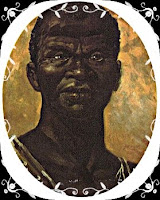The
Cimarrons or Cimarrones in
Panama, were
enslaved Africans who had escaped from their Spanish masters and lived together as outlaws. In the 1570s, they allied with
Sir Francis Drake of England to defeat the Spanish conquest and plunder their riches. In
Sir Francis Drake Revised (1572), Drake describes the Cimarrons as "a black people which about eighty years past fled from the Spaniards their masters, by reason of their cruelty, and are since grown to a nation, under two kings of their own. The one inhabiteth to the west, the other to the east of the way from
Nombre de Dios".
[1]
Etymology
The term Cimarron, apparently from the
Taino word "si'maran," for "the flight of an arrow,"
[2] refers mainly to enslaved African who ran away from their Spanish masters. There existed many groups of slaves throughout Latin America called cimarrones or
Maroons, and this specific group may have been named so by Sir Francis Drake and his men.
History
Slave rebellions and uprisings in the New World were very common during the first years of exploration. Runaway slaves were prevalent in Brazil as well, where they were known as
palenques, cumbes and
quilombos. These runaway slaves fled from the mines and Spanish towns and built their own nearly independent towns. Such towns hosted a blend of cultures and a diversity of traditions from African, Euroamerican and Indigenous roots.
The Cimarrons in Panama were African slaves who abandoned their Spanish masters in the mid 16th century. When brought to Panama, they intermarried with the Indians and immediately learned the land in order to outsmart the Spanish. An estimated 3,000 of them lived in Nombre de Dios, a town on the Caribbean side. Their principal settlement was at
Vallano (or Bayano), 30 leagues below Nombre de Dios. Many lived in large settlements of in hideouts concealed in the inhospitable mountains. They frequently organized raids on the Spanish settlements and had threatened to burn down Nombre de Dios. They often stole treasure from the Spanish and concealed it in the river. When the Spanish once prepared to send an expedition against them, they constructed gallows on the main road and threatened to hang and decapitate the Spanish if such a mission was undertaken.
The Spanish feared that the Cimarrons would join forces with the Indians and stage a mass rebellion. To prevent this, they issued strict laws of punishment, called
Ordenazas para los negros. If a slave ran away from his Spanish master and joined the Cimarron outlaws, he was to be hanged (if recaptured). The Indians, who were treated much better than slaves, were also punished with severity if they joined the Cimarrons.
The Cimarrones valued iron to the extent that the Spanish and English valued gold. They used iron to build the heads of their arrows which they used for hunting and for protection against the Spanish. They were also skillful in that they could very quickly prepare shelters made out of palm trees which were waterproof and could be warmed with ventilated fires. The Cimarrones were not only hunter-gatherers but rather had extensive and well-defended settlements, sometimes numbering over sixty household





